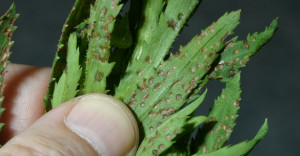
As pretty as they are, fourlined plant bugs like to stay out of sight. Look for damage first, then the bugs.
I ran a story about this insect 5 years ago, and thought it might be time for a refresher course. The fourlined plant bug, Poecilocapsus lineatus, is a small, attractively colored insect that is active right now. Don’t be fooled by its pretty face. This insect has been recorded as a pest from about 250 different plant species, both herbaceous and woody plants. Herbs, mints, and composite flowers seem to be especially favored.
What makes the fourlined plant bug unique is the rather severe damage (see image) that can be caused by relatively few individuals. Its damage is one of the most severe for a leaf-feeding bug of this size, according to USDA scientists who recently reported on the feeding behavior of these insects. They found that the four-lined plant bug’s saliva, produced by unusually large salivary glands, making up 15-20% of the insect’s body weight. In addition the saliva itself packs a special punch. Special enzymes attack the glue that holds plant cells together, causing pits in the leaves where the cells literally collapse after feeding.
The damage on some plants look like round pits or craters. On other plants feeding spots are delineated by leaf veins. The pitted areas eventually turn black or translucent, and may eventually drop out of the leaf, leaving holes that sometimes looks more like a caterpillar than a sap-feeding insect.
Most of the damage seems to be caused by the nymph stage. By the time adults appear much of the damage has been done.
Treatments for fourlined plant bugs include insecticidal soaps, oils or other insecticides labeled for the plant attacked. Soaps and oils will be most effective on the wingless nymphs, and may not harm the adults. Sevin, malathion, and some of the newer pyrethroids, such as cyfluthrin and permethrin, should work well against both nymphs and adults.
If a close inspection of the plant reveals no insects, don’t treat. Also restrict your treatments to just those plants in the garden that show damage. There is little need to treat other plants and you’ll minimize your impact on beneficial insects. And don’t treat plants in bloom that are attracting bees. If you need to treat flowering plants, do it late in the day, just after sunset when bees are no longer foraging.
